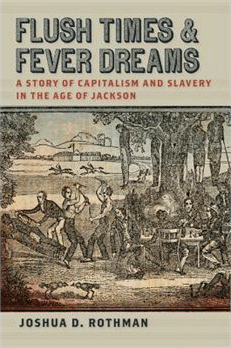By Louis J. Kern
Greil Marcus observed in The Shape of Things to Come that “America is a place and a story, made up of exuberance and suspicion, crime and liberation, lynch mobs and escapes; its greatest testaments are made of portents and warnings.” Nowhere was that truer than on the cotton frontier of west central Mississippi in the 1830s. In an environment of economic boom times—infinitely expansive credit, unregulated state banks, and a speculative fever caused by the opening of federal lands expropriated from the Choctaws in 1830—a precarious cotton plantation economy resting on a pyramid of debt and utterly dependent on slave labor emerged. The slave economy was profoundly unstable and white anxieties intensified when by 1836 the black population of the state predominated.
In terms of the American myth of the self-made man, it would seem that the risky economy of the southwestern frontier was the ideal stage for the social advancement of the common man. But as Rothman shows in his masterly discussion of the successive failures of Virgil Stewart, without familial ties or economic resources, that promise was illusory. The story he tells is at once fascinating, disillusioning, and horrifying. Unsuccessful in either Tennessee or Mississippi, Stewart sought honor and respectability in publishing an account of his adventures in pursuit of a slave stealer entitled A History of the Detection, Conviction, Life, and Design of John A. Murel, the Great Western Land Pirate (1835). A mixture of braggadocio, frontier tall tale, and western adventure story, outlandish as it was, one aspect—his contention that Murrell headed a vast criminal conspiracy imminently planning a series of slave uprisings throughout the South —was to prove momentous.
Given the economic insecurities and racial fears of plantation owners, Stewart’s warning of slave rebellion and incendiary violence, however patently incredible, was readily accepted as fact in central Mississippi. In July 1835 paranoia gripped the region and vigilante groups were rapidly assembled to protect the lives and property of slaveholders. In Madison County, the center of the hysteria, five white men, believed to be ringleaders and a dozen slaves were lynched by committees of safety that had usurped regular law enforcement and judicial functions.
Rothman carefully explains why conspiratorial claims were so readily accepted and what the consequences of lynch law were for this county, for the South, and for the broader nation. He cites the recent Nat Turner rebellion in Virginia (1831) and persistent dread stemming from the Haitian Revolution (1791-1804). Belief in criminal conspiracies mounted by unsavory whites who threatened the propertied rested too on the prevalence of highwaymen like Alonzo Phelps, who rejected racial hierarchy in his Confession (1834).
Rothman skillfully links the contemporaneous lynchings of five professional gamblers in Natchez to those in Madison County, arguing that guilt and insecurity about the speculative cotton economy led to a fascination with-resentment of aleatory gaming. Finally, he argues that the southern mind linked gamblers, slave conspirators, and abolitionists, a fatal concatenation of hostile forces threatening the plantation economy, leading to the refusal to accept any material critical of slavery—the closed South. When the cotton bubble collapsed with the Panic of 1837, not only the South but the entire nation suffered epidemic economic decline since northern capital was intimately connected to cotton and deeply invested in slavery. As Rothman concludes, by the 1840s “looking away was no longer possible,” the first steps toward Civil War had been taken.
Louis J. Kern (ΦBK, Clark University,1965) is professor emeritus of history at Hofstra University. Hofstra University is home to the Omega of New York chapter of Phi Beta Kappa.




